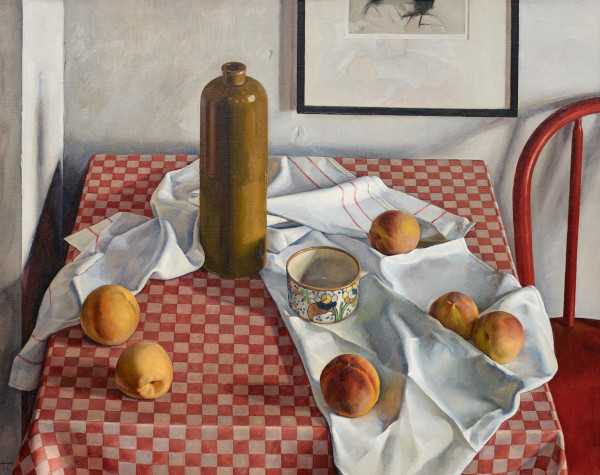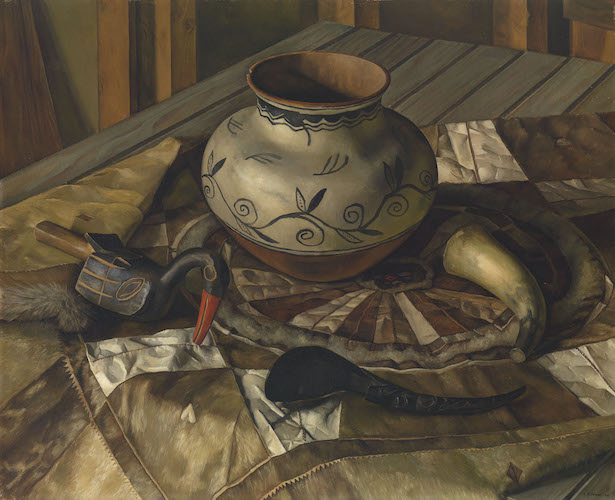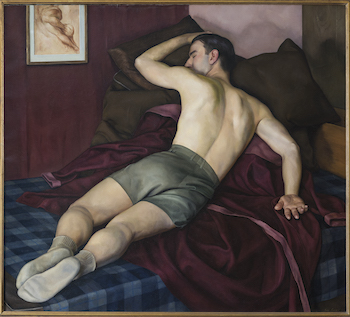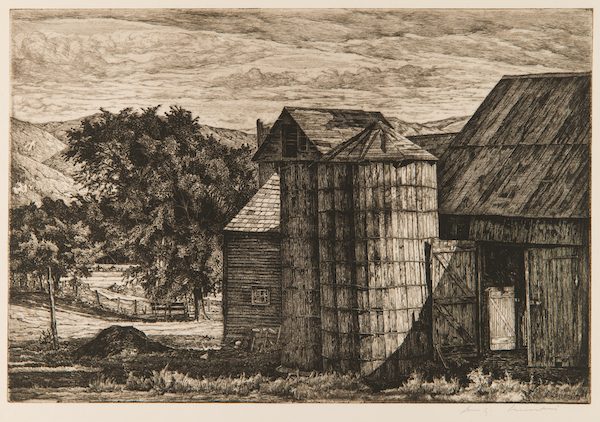Visual Arts Review: “Luigi Lucioni: Modern Light” — Cranking up the Realism
By Franklin Einspruch
A valuable reminder that the provinces have their advantages, as the Shelburne Museum devotes lavish attention to a Vermont master.
Luigi Lucioni: Modern Light at the Shelburne Museum, 6000 Shelburne Road, Shelburne, Vermont, through October 16.

Luigi Lucioni, Within the Birch Grove, 1957. Photo: Courtesy of Southern Vermont Arts Center.
In the 1930s in Greenwich Village, a creative circle coalesced around the painter Paul Cadmus, who had become known for bawdy, satirical figurative paintings in egg tempera. It included Jared French, another egg tempera painter, the critic Lincoln Kirstein, photographer George Platt Lynes, and the author and photographer Carl Van Vechten. It later involved the artist Margaret Hoening, who married French, and the younger painter George Tooker, who learned egg tempera from Cadmus and developed a related but distinct voice in the medium. Describing the romantic relations between all of these figures would require more copy than is relevant to this review’s purpose. Suffice it to say that it wouldn’t be unfair to characterize the group as polyamorous homosexual aesthetic reactionaries.
Interestingly, all the painters finally decamped to New England, Tooker and the Frenches to Vermont (separately, it should be said, because Cadmus was living in the French compound for a while) and Cadmus finally to Connecticut.
As a fan of Cadmus and Tooker, I thought that I knew this scene pretty well. But my monographs on the two masters neglect to mention one Luigi Lucioni, whose works are the subject of an intriguing exhibition at the Shelburne Museum, Luigi Lucioni: Modern Light. (I blame not the monographs, but myself for not yet catching up with a couple of newer histories, Intimate Companions by David Leddick and The Young and Evil by Jarrett Earnest.) Lucioni was right there in the Village with Cadmus and French in the early years, painting in oil with the same assiduous realism, as if all of the art history since Ingres had never taken place. Stunning portraits of Cadmus and French by Lucioni appear in the show. The knowing looks on their faces make plain that Lucioni was in on the fun.

Luigi Lucioni, Still Life with Peaches, 1927. Photo: Courtesy of Shelburne Museum.
(If we’re going to read that much into the portraits of Cadmus and French, we may as well admit that the hard look in the eyes of the 1945 portrait of Lucioni’s father shows him wondering if his boy has turned out to be some kind of pansy. Nevertheless the artist captures the life of labor wreaked on the old man’s hands with full respect.)
Lucioni too fell in love with Vermont. Born north of Milan in 1900, he immigrated to New Jersey at the age of ten, won admission to Cooper Union at the precocious age of fifteen, and by nineteen was painting under John Sloan and Childe Hassam at the Tiffany Foundation in Long Island. He had relatives in the granite business in Barre, Vermont, and visited them periodically. He grew well enough known in Manhattan by his early thirties to capture the attention of the woman who would found the Shelburne Museum, the magnificently named Electra Havemeyer Webb. Webb invited Lucioni to call on her in Shelburne in the early ‘30s, and clan Webb subsequently commissioned or purchased dozens of Lucionis over the rest of his working career. The association is memorialized in a 1937 house portrait of the Webb manse, sun-dappled and striking red against the verdure. A playroom there was cleaned out to give him a studio. He subsequently acquired a property of his own not far off, and thereafter split his time between there and New York City. Life Magazine, in 1937, dubbed him the painter laureate of Vermont.
In other circumstances, the circle of Cadmus could have hailed themselves as a distinct movement (The “Fabulous Realists”? The “Derriere-Garde”?) and proceeded as a patently gay challenge to the burgeoning forms of American abstraction. New York art history would have ended up looking quite different. But to make one’s homosexuality public knowledge at that time was to invite destruction to both career and person. Cadmus and French alluded to male-male desire throughout their work, but Lucioni and Tooker were more reticent. Their discretion is understandable, in light of a cruel passage excerpted in the Modern Light catalogue from a 1934 book on art of the time. Its author sneers, “On the whole, our museums are gilded show places stuffed with inferior old masters and directed by soft little fellows from the Fogg factory who use pictures to titillate mischievous erotic appetites.” The Fogg is the Harvard museum where eventual Wadsworth Atheneum and Ringling Museum director Chick Austin, at whom that crack was directed, got his start.

Luigi Lucioni, Americana, 1930. Cincinnati Art Museum, Museum purchase. Photo: Bridgeman Images.
As far as I’m concerned, blessed are the soft little fellows, for they shall inherit the arts.
Cadmus, despite his appetites, was an intensely moral figure who later in life declined to participate in a Pride exhibition because pride, he noted, is a sin. Tooker was a serious Catholic. Their embrace of forms of labor-intensive realism also could be seen as a moral stance, as a discipline set against indulgence and indolence. Each separately partnered long-term. Lucioni did not, and details regarding companionship after his younger adventures in New York are scant. Unlike his confreres, Lucioni seems not to have worked out the tensions between desire and principle, either in his life or his art. Whether he couldn’t, wouldn’t, or didn’t care to, is an open question.

Luigi Lucioni, Resting Athlete (Amateur Resting),1938. Oil on canvas. Photo: Anton Grassl.
That is something of a shame, because it would have been grand to see more works like Resting Athlete (Amateur Resting) from 1938. This dorsal view of a Cuban socialite in khaki shorts and socks is four feet wide, beautifully colored, arranged in a subtle, dynamic X composition, and drawn with the kind of sensitivity only possible when fine technique is powered by great affection. The right arm leading to the supine hand is gracefully painted and breathtakingly vulnerable.
Alas, he gave up on work like this to paint pictures of barns. That’s where the market was, at least for a while. The subject matter didn’t risk outing the artist, and it allowed him to crank up the realism. He rendered every board of siding in Vermont Survival from 1958 with reverence. One of the roofs is sagging gently over its beams; the viewer can sense them like ribs through the skin of a torso. The painting’s dour tone relative to Shelburne House is evidence of Lucioni’s emotional range, expressed even through the inanimate.
Modern Light arranges a corner of the exhibition with the artist’s portrayals of birches, and it’s the most sublime spot at a New England museum at the moment. It’s tempting to call painting of this sort photographic, but you wouldn’t be able to capture this kind of detail and luminosity with a camera. Everything is resplendent in Within the Birch Grove (1957), the silver bark, the shaded grass, the church steeple in the distance, the mountains and sky beyond. These are masterpieces on par with Ruysdael, but conspicuously American and products of the 20th century.
Lucioni was just as powerful tackling the still life. Still Life with Peaches (1927) is not only an astonishing feat of verisimilitude, it has the graphic cohesiveness of a good abstraction and a pleasingly warm tone. Literary and art historical notes are buried throughout Anachronisms (1930) and Contemporary Conversations (1933). He etched as well, the needle playing to his powers of observation. Late Shadows from 1945 depicts one of his farmscapes in all its gritty glory.

Luigi Lucioni, Late Shadows, 1945. Collection of Shelburne Museum. Photo: Andy Duback.
Whatever unkindnesses these painters encountered as gays, what time did to them was at least as abusive. By 1970, Cadmus, who had similarly been recognized as a Wunderkind and had been included in more Whitney Biennials than any other artist, was all but discarded. The Cadmus exhibition that historian Philip Eliasoph mounted in Ohio in 1981 practically gave him a second career. The Modern Light catalogue lists no items for Lucioni between a retrospective at the Shelburne in 1968 and his death in Greenwich Village twenty years later. If Manhattan had ever figured in his work, perhaps Manhattanites would have felt more inclined to keep it in mind. The provinces nevertheless have their advantages, and the Shelburne has done a beneficent and wise thing by remembering Vermont’s painter laureate.
Franklin Einspruch is an artist in New Hampshire. He is the editor of Aphorisms for Artists: 100 Ways Toward Better Art by Walter Darby Bannard (2022, Letter16 Press). Follow his publishing and exhibition concern, Dissident Muse, at Dissident Muse Journal and on Twitter @dissident_muse.
Tagged: Franklin Einspruch, Luigi Lucioni, Luigi Lucioni: Modern Light

Excellent review and again I am grateful to become aware of another artist to explore. As a long-time lover of Andrew Wyth, Lucioni’s works certainly seem to be exploring many similar themes and subjects.
I’m wondering if Luigi Lucioni tried egg tempera like Cadmus, French and Tooker. There seem to be no clues.